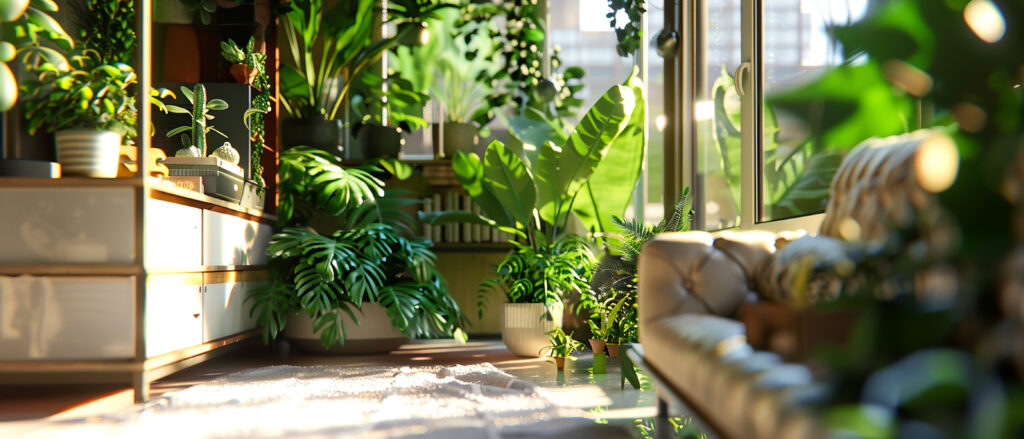Transform your living space into an urban jungle by thinking vertically. Vertical gardens offer endless possibilities for bringing nature indoors while maximizing your available space. From simple wall-mounted planters to elaborate living walls, vertical gardening allows you to create stunning green displays that become the focal point of any room.
Design Approaches for Vertical Gardens
The beauty of vertical gardening lies in its versatility. A minimalist approach might feature clean lines of identical planters arranged in a grid pattern, creating a modern, structured look. For a more organic feel, mix different sizes and styles of planters, allowing plants to cascade naturally between levels. This creates a more dynamic, living art piece that evolves as your plants grow.
Frame your vertical garden like artwork by choosing containers and supporting structures that complement your decor. Copper pipes and leather straps offer an industrial-chic look, while natural wood and macramé bring a bohemian vibe. The framework becomes part of the design, enhancing rather than detracting from the overall aesthetic.
Creative Container Solutions
Think beyond traditional planters when designing your vertical garden. Repurposed items like wine boxes, mason jars, or vintage tins add character and charm while providing unique growing spaces. Paint or finish these containers to coordinate with your color scheme, creating a cohesive look that ties into your overall design.
Wall pocket planters offer flexibility in arranging your vertical garden. These fabric or plastic pouches can be rearranged as your plants grow or your design preferences change. Group them in clusters for impact, or spread them out to create a scattered, organic pattern across your wall.

Plant Selection and Arrangement
Choosing the right plants makes all the difference in vertical gardening success. Combine plants with different growth habits to create visual interest. Upright plants provide structure while trailing varieties soften edges and create movement. Plants with interesting foliage patterns add depth and texture to your living wall.
Consider the visual weight of your plantings when designing your vertical garden. Place more extensive, fuller plants at the bottom, transitioning to lighter, airier specimens toward the top. This creates a natural flow and prevents your display from feeling top-heavy. Mix leaf sizes and shapes to create contrast and maintain visual interest throughout the composition.
Innovative Mounting Systems
Modern vertical gardening systems offer innovative solutions for securing plants to walls. Magnetic planters provide flexibility in arrangement while maintaining a clean look. Modular systems allow for easy expansion and reconfiguration as your garden grows. Hidden mounting brackets focus on your plants while ensuring stability and proper support.
Integrate your mounting system with proper irrigation to simplify maintenance. Self-watering systems can be concealed within wall-mounted frames, providing consistent moisture while maintaining a polished appearance. Drip irrigation systems hidden behind plants ensure even water distribution without visible equipment.
Lighting Integration
Strategic lighting transforms your vertical garden from day to night. Integrate grow lights that double as accent lighting, highlighting your plants while ensuring they receive adequate light for growth. LED strip lighting behind planters creates a dramatic glow, making your vertical garden an even more striking focal point after dark.
Position your vertical garden to take advantage of natural light when possible. South-facing walls offer ideal conditions for sun-loving plants, while north-facing locations work well for shade-tolerant varieties. Understanding light patterns helps you choose appropriate plants and supplemental lighting needs.
Space Division
Use vertical gardens as natural room dividers in open floor plans. Freestanding vertical gardens create privacy while maintaining airflow and light transmission. These living screens can define spaces within larger rooms while providing the benefits of improved air quality and acoustic absorption.
Create zones within your space by varying the density and style of plantings. A dense, lush section might designate a quiet reading nook, while a more open arrangement could define a social area. This thoughtful placement helps guide movement through your space while maintaining visual interest.
Seasonal Adaptations
Design your vertical garden to shine throughout the year. Include evergreen plants for year-round structure, supplemented with seasonal additions that provide changing color and interest. This approach ensures your vertical garden remains attractive while allowing for periodic updates and refreshes.
Adapt your plant selection and care routine to seasonal changes in light and temperature. Move sensitive plants to more protected positions during winter and adjust watering schedules to match seasonal needs. This flexibility helps maintain the health and appearance of your vertical garden throughout the year.
Maintenance Integration
Incorporate easy-access points for plant care into your vertical garden design. Removable panels or hinged sections allow simple maintenance while maintaining a clean aesthetic. Include hidden storage for tools and supplies nearby, making routine care more convenient.
Design your vertical garden with growth in mind. Leave space for plants to mature and spread, and plan for eventual replacement of shorter-lived specimens. This foresight helps maintain the long-term appeal of your living wall while minimizing significant overhauls.
Your vertical garden should reflect your style while functioning effectively in your space. Regular observation and minor adjustments help your garden evolve beautifully over time. Through thoughtful design and careful plant selection, your vertical garden will become an ever-changing piece of living art that enhances your environment and brings nature into your daily life.




